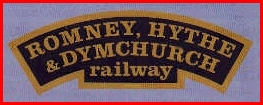

Although I'm a great steam fan and make frequent visits
to preserved railways the greatest thing for me about the
RHDR is that's it's not a preserved railway at all - it's
a railway that just kept going down the years (sometimes only
just), more or less as it was when built. This is not
a place where displaced steam leviathons trundle meekly up
and down at limited speeds with a few odd coaches in tow;
this is the mainline, albeit shrunk to 15" gauge, where
the locos work flat out to earn their keep.
The RHDR have their own web site with all the history, timetables etc and there would be no point in reproducing it's contents here. So here are a few facts, my personal opinions and recommendations and some photographs I've taken down the years. Take your pick!
The Romney Hythe & Dymchurch Railway was built in the late 1920's to the order of one Captain J.E.P. Howey, a wealthy former army officer whose family owned substantial amounts of land in Australia. Howey commisioned the then pre-eminent model/light railway engineer Henry Greenly to locate a site and design and build a 15" gauge line that would be a showcase of its kind. The Captain was also a keen racing driver and one of his racing friends Count Louis Zborowski (of Chitty Chitty Bang Bang fame) ordered two Greenly designed 4-6-2's from the engineering company Davey-Paxman - sadly the Count never saw them in service, being killed during a race at Monza before the railway opened.
The railway opened originally as a double track line between Hythe and New Romney, but the Captain already had his eye on an extension and before long work began on the double track section from New Romney to Dungeness. More locomotives followed including two 4-8-2's for freight traffic which never really amounted to much. Eventually Howey and Greenly fell out over various matters and Greenly left the scene. However design work was partly completed for two Canadian Pacific type locomotives at this time and the unfinished drawings were sent to the Yorkshire Engineering Company who completed the two locomotives,improvising from photographs of the real thing where required .
World War 2 saw the railway being requisitioned by the army for the movement of troops and supplies. An armoured train was constructed around one of the 4-8-2's intended as an anti-aircraft patrol. It seems unlikely that it ever shot down anything but one plane is reputed to have crashed after mistaking the little train for the full-size object and flying too low. In the latter part of the war the line was involved in the construction of PLUTO (Pipeline Under The Ocean) which lead to much damage being caused to the Dungeness section of the line.
When Howey regained control of the railway at the end of the war he could only manage to rebuild the damaged New Romney to Dungeness section as single track and it remains so to this day. Now the railway had a relative boom period with the Kent coast being a popular holiday destination for many Britains. From this time up until his death in 1963 the Captain showed little interest in upkeep of the railway - indeed he always maintained that it was built to last his lifetime and didn't care what happened afterwards. He did however perform one act in his latter years which in retrospect may have saved the railway - he paid to have all of the locomotives reboilered.
Upon the Captain's death ownership of the railway passed to his wife Gladys who was quick to sell it to two local businessmen. They soon discovered that things were not as they seemed - Howey's lack of investment had led to severe problems with bridge and trackwork as well as coaching stock. They set about repairing or replacing the must urgent items (the bridgework being the most serious) but soon sold the railway. Eventually the railway was accquired by a consortium of weatlhy enthusiasts. By this time, with the event of cheap foreign holidays, the Kent coast was in serious decline as a holiday destination and the railway was in a similar state. There was talk of closure or wholesale relocation to a more popular site. However the railway managed to scrape through and to this day at least remains a non-loss-maker even though it may never make its owners rich!
Planning Your Visit ¦
Things To Look Out For
Eating, Drinking, Shopping ¦
JR's Snapshots
Working The Bar Car